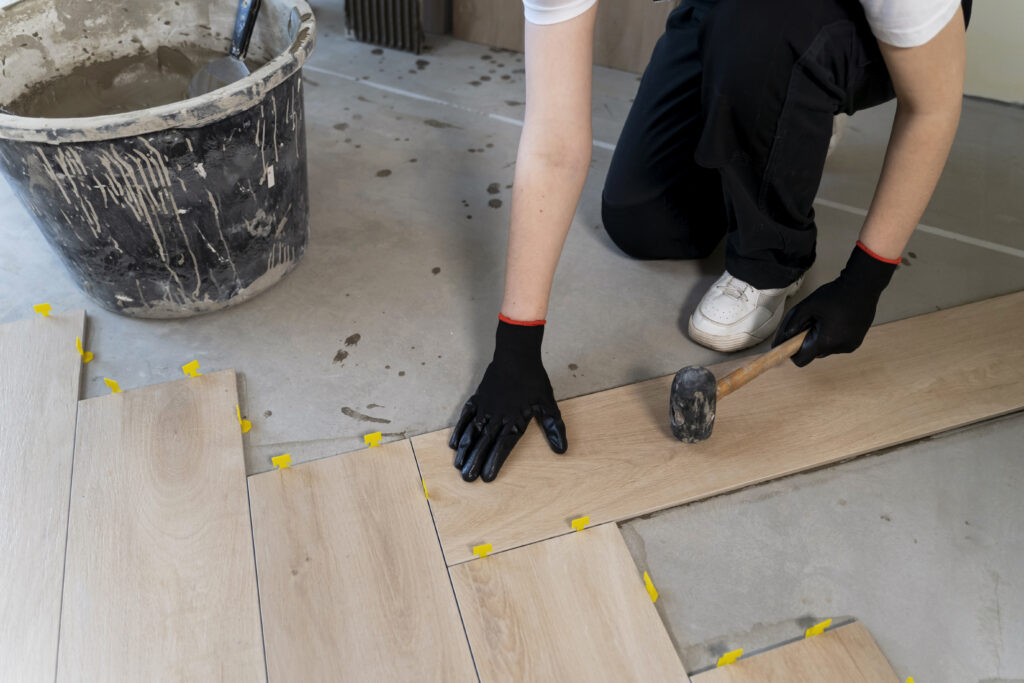Tile floors are known for their hardiness and good looks. But, they can crack due to bad setup or hard hits. If your tile has small, hairline cracks, you might not need to replace it. You can make it look good again with some smart fixes, avoiding the trouble of taking it out.
This guide will teach you how to mend cracked tile and fix a broken floor tile without replacing it. By doing what we suggest, you’ll not only solve the visual problems but also seal the cracks well, making them almost disappear. If the damage is big, like seriously broken tiles, you might have to put in new ones, especially if the problem comes from the foundation or how they were put in. But for small issues, quick fixes can save you both time and money.
Understanding the Causes of Cracked Tiles
Finding out why tiles crack is key to fixing and avoiding more issues. Several factors are behind the causes of tile cracks. Knowing them lets you find the right ways to keep your floors in good shape.
Impact Damage
Impact damage on tiles is a main reason for tile cracks. It happens when heavy items like pots or furniture hit the floor. This leads to small cracks that can get bigger if you don’t fix them fast.
Improper Installation
Bad installation is also a big cause. It occurs if the base is uneven, there’s not enough glue, or the tiles are too close. If tiles aren’t put in right, they crack easily, sometimes on their own.
Wear and Tear
Using your floors can cause wear and tear on floor tiles over time. This issue gets worse with changing temperatures and dampness. Lots of walking on the tiles can make them crack easier, too.
Tools and Materials Needed for Tile Repair
To fix cracked tiles and make sure the repair lasts, you need the right stuff. You’ll require various DIY tile repair tools and materials. They help you do the job well and safely.
Essential Tools
A claw hammer, chisel set, and grout float are key tools. They help take out the broken tile without harm to others. Grout blades and saws are for slicing old grout. A wet & dry vacuum and cleaning rags keep the area clean and dust-free. You might also need paint and brushes for looks, and painters’ tape to shield the area.
Choosing the Right Adhesive
Finding the best tile adhesive makes sure your repair looks good and lasts. Two-part clear epoxy is top choice for a strong, invisible hold on your tiles. For small cracks, pre-mixed grout and urethane sealant work well. A top-notch adhesive keeps your tile work solid.
Safety Gear
It’s key to wear safety gear for tile repair to stay safe. Safety glasses and work gloves protect against adhesives and sharp tools. A face mask keeps you from breathing in dust and bad stuff, especially with epoxy. Right safety gear means a safer, better repair job.
Assessing the Damage
It’s very important to correctly assess the damage for a good tile repair. You must evaluate the extent of the cracks well. This helps you find out why the tiles got damaged. Then, you can pick the best way to fix them and keep problems away in the future.
Evaluating the Extent of Cracks
First, look at how deep and broad the damage is when you evaluate tile cracks. Small, thin cracks might just need some epoxy to fix them. But bigger cracks could mean you need to replace the whole tile. Check the cracks closely with a magnifying glass to see if they go into the grout or under the tile.
Determining the Cause
Finding out why tile cracks happened can stop them from coming back. Sometimes, cracks happen if something heavy is dropped on them. Or, they could be from not putting the tiles in right. This could mean the adhesive wasn’t good or the floor below wasn’t prepared well. Settling or water damage could also cause cracks. Knowing the exact reason helps you pick the best way to fix it. Plus, it makes sure your tile lasts a long time.
Preparing the Cracked Tile for Repair
To fix cracked tiles well, preparing them right is key. It’s not just about using glue. Knowing the correct steps before starting is crucial. Let’s look at how to get a tile ready for fixing.
Cleaning the Tile
First, clean the cracked tiles well to take off dust, dirt, or grease. Begin with a vacuum for loose bits, then wash the tile with soapy water. Finish by wiping it down with rubbing alcohol and let it dry completely.
Removing Surrounding Grout
Then, work on removing grout tips around the broken tile. Gently use a grout saw or a multi-tool to take out the grout. This exposes the crack better and helps the repair material stick well.
Go slow to keep from harming nearby tiles. Taking care this way helps ensure a strong and lasting repair.
Repair Cracked Tile with Epoxy
Epoxy is a great choice for fixing cracked tiles. This method makes a strong bond that matches your tile’s surface well.
Mixing the Epoxy
The first step in fixing tile with epoxy is mixing it well. It’s very important to follow what the maker says to do. Mostly, you mix equal parts resin and hardener in a throw-away container, mixing well until it looks the same throughout.
Applying Epoxy to Cracks
Knowing how to use epoxy right is key. Use a small brush to put the epoxy into the cracks, covering them completely. Make sure not to fill it too much to keep it looking smooth. Wipe away any extra before it dries.
Allowing Epoxy to Cure
The last step is to let the epoxy dry on the tiles. Give the epoxy enough time to dry, like the maker says. This could take a few hours or overnight. It’s needed to make sure the bond is strong and your tile is good as new.
Painting and Sealing the Repaired Tile
Once you fix your cracked tile with epoxy, don’t forget to paint and seal it. These steps make sure the repair looks like the other tiles and stays safe. You’ll need to follow some important steps to get a neat and durable finish.
Selecting Paint to Match Tiles
Finding the right paint is key for a seamless look. First, figure out what color and finish your tiles have. Take a piece of your tile to a paint store for help mixing the perfect paint. Or get pre-mixed tile paint from certain brands. Pick durable, quality paint made for tiles to handle daily use.
Applying Clear Urethane Sealer
After painting, apply urethane sealer to protect your work. This clear coat keeps your tile safe from moisture and damage. Use a clean brush or roller for an even coat. Let it dry as the label says. This step keeps your repair strong and the color bright for longer. It also makes your fixed tiles look good as new.
Maintaining Your Repaired Tiles
After fixing your tiles, it’s important to keep them looking new. Proper care will ensure they last a long time.
Regular Cleaning Tips
Regularly cleaning your tiles is key. Use a gentle cleaner to avoid harming the sealant. Here are some tips for cleaning tiles:
- Avoid harsh chemicals and abrasive scrubbers.
- Use a soft cloth or sponge for daily cleaning.
- Mop with a mild detergent solution regularly.
- Dry the tiles thoroughly to prevent mold or mildew build-up.
Clean tiles often to keep them shiny. This also helps keep the tiles strong by stopping any damage from building up.
Preventing Future Cracks
Preventing more damage to your tiles is crucial. Here are ways to prevent tile cracks:
- Avoid placing heavy items directly on the tiles.
- Ensure even and proper substrate preparation during installation to prevent uneven settling.
- Use soft pads under furniture legs to reduce stress on the tile surface.
- Address any structural issues in your home that could lead to tile shifts or movements.
Using these tips can help avoid future cracks. This keeps your floors looking good for a longer time.
When to Consider Professional Help
Fixing small tile issues by yourself can be rewarding. But, there are times you really need a pro. If you’re dealing with big damage, lots of cracks, or problems below the surface, get an expert. They know how to fix things without making them worse.
Understanding when to hire a tile professional can save you time and money. And make sure your fix lasts. If you see multiple tiles damaged or cracks getting wider, it’s time to call in the experts. They have special skills that can make repairs last longer and look better.
If you need to match new tiles to old ones, or fix what’s beneath them, a professional is the way to go. They can find the perfect match for your tiles. This keeps your floors or walls looking good.
Tile experts can also find problems you might not see on your own. Things like water damage, foundation problems, or bad installations. Fixing these issues early on can stop more damage later. This helps your repair last longer.
In the end, knowing when to bring in a tile pro is key to keeping your tiled areas in top shape. Getting professional help solves the problem the right way the first time. Plus, it gives you confidence that you won’t have to fix the same thing again soon.
Conclusion
We’ve learned fixing cracked floor tiles is a key skill for home upkeep. A useful guide on DIY tile repair shows that the right tools and materials make it easy to fix minor damage. This way, you can make your floors last longer.
Before you start, it’s crucial to know how badly the tile is damaged. Prepare your tile well for the best fix. The repair might not be perfect, but it will look better than a crack.
Keeping your tiles in good shape requires regular care. Clean them often and fix small problems quickly for long-lasting floors. For big issues, getting help from experts is smart. This keeps your floors looking great and working well, adding beauty and value to your home.
FAQ
What causes tiles to crack?
Dropping heavy objects on tiles can crack them. They may also crack if not installed properly, like on an uneven surface or with bad glue. Wear and tear over time is another cause.
What tools and materials do I need to repair a cracked tile?
You’ll need a vacuum, small paintbrushes, dish soap, and rubbing alcohol. Don’t forget safety gear and two-part clear epoxy for gluing.
How do I assess the extent of the damage?
Look closely at the cracks. Figure out if they’re from dropping things, bad installation, or problems with the base. This helps you know how to fix them.
What steps are involved in preparing a cracked tile for repair?
Start by cleaning the tile well to get rid of dirt and oil. Use a vacuum, then scrub with dish soap and water. Finish by wiping it down with rubbing alcohol. You also need to remove any old grout around the tile.
How do I repair a cracked tile with epoxy?
Follow the epoxy’s mixing instructions. Fill the cracks carefully to cover them well. Let it dry as long as the label says to make it strong.
How can I match the repair with the rest of the tile?
Paint over the fixed spot to blend it in with the old tile. Seal it with clear urethane to keep it safe and make it last.
What are the best practices for maintaining repaired tiles?
Clean the tiles gently without strong cleaners that can harm the glue or sealant. To avoid new cracks, don’t drop heavy things on them and make sure they’re installed right.
When should I consider professional help for tile repair?
If the damage is big, or if you find a lot of cracks, get help from experts. They know how to fix it best, find matching tiles, and solve big problems to make sure everything lasts.





